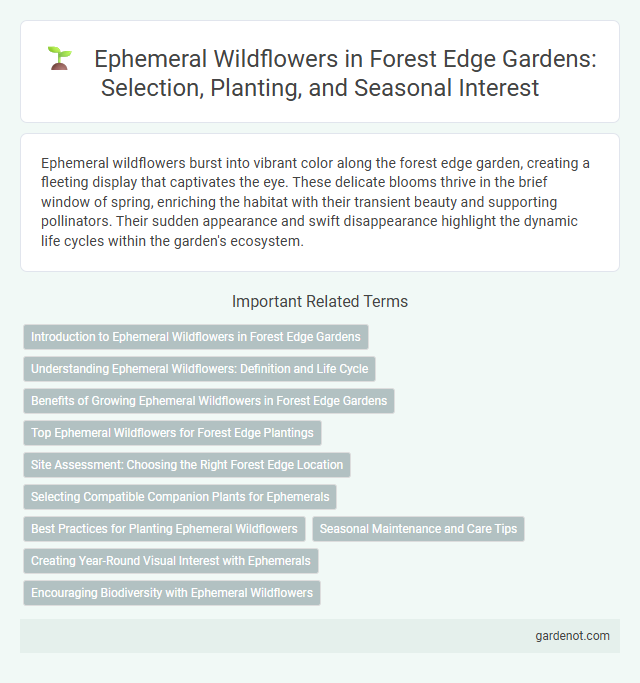Ephemeral wildflowers burst into vibrant color along the forest edge garden, creating a fleeting display that captivates the eye. These delicate blooms thrive in the brief window of spring, enriching the habitat with their transient beauty and supporting pollinators. Their sudden appearance and swift disappearance highlight the dynamic life cycles within the garden's ecosystem.
Introduction to Ephemeral Wildflowers in Forest Edge Gardens
Ephemeral wildflowers in forest edge gardens are short-lived plants that bloom briefly during early spring, capitalizing on sunlight before tree canopies fully develop. These wildflowers, such as trilliums, bloodroot, and spring beauty, play a crucial role in supporting pollinators and maintaining biodiversity along forest margins. Their rapid life cycle and unique adaptation make them essential for the ecological balance and aesthetic value of forest edge environments.
Understanding Ephemeral Wildflowers: Definition and Life Cycle
Ephemeral wildflowers are plants that complete their entire life cycle rapidly, typically within a few weeks, taking advantage of short favorable conditions at the forest edge. These wildflowers germinate, bloom, and set seed before the canopy closes, ensuring reproduction before light availability diminishes. Their life cycle is closely linked to seasonal cues and soil moisture, allowing them to thrive in transient habitats with minimal competition.
Benefits of Growing Ephemeral Wildflowers in Forest Edge Gardens
Ephemeral wildflowers in forest edge gardens enhance biodiversity by providing early-season nectar and pollen for pollinators such as bees and butterflies. These wildflowers improve soil health through natural nutrient cycling and reduce erosion with their root systems. Cultivating ephemeral species supports ecosystem resilience by creating habitat continuity between woodland and open areas.
Top Ephemeral Wildflowers for Forest Edge Plantings
Top ephemeral wildflowers for forest edge plantings include Bloodroot (Sanguinaria canadensis), which thrives in rich, moist soil and blooms early in spring with striking white flowers. Trilliums (Trillium spp.) offer vibrant, three-petaled blossoms that carpet the forest floor, providing essential early-season nectar for pollinators. Virginia Bluebells (Mertensia virginica) are another prime choice, known for their bell-shaped, blue flowers that brighten shaded edges and support local wildlife.
Site Assessment: Choosing the Right Forest Edge Location
Ephemeral wildflowers thrive in forest edge gardens with well-drained soil and partial sunlight, making site assessment crucial for successful growth. Selecting locations with adequate moisture retention and protection from strong winds enhances their delicate life cycle, which relies on early spring conditions before the canopy fully develops. Soil pH between 5.5 and 6.5 supports nutrient availability critical for these wildflowers' rapid germination and blooming phases.
Selecting Compatible Companion Plants for Ephemerals
Selecting compatible companion plants for ephemeral wildflowers enhances their growth by providing necessary shade and soil moisture during critical blooming periods. Plants such as ferns, shade-loving grasses, and early-blooming spring ephemerals like trilliums and bloodroot create a supportive microenvironment that mimics natural forest edge conditions. This strategic pairing ensures nutrient sharing, reduces competition, and promotes biodiversity within forest edge gardens.
Best Practices for Planting Ephemeral Wildflowers
Plant ephemeral wildflowers in shaded or partially shaded areas near the forest edge to mimic their natural habitat and enhance growth success. Use well-drained, nutrient-rich soil amended with organic matter to foster healthy root development and vibrant blooms. Sow seeds in late fall or early spring to align with natural seasonal cycles, ensuring optimal germination and establishment.
Seasonal Maintenance and Care Tips
Ephemeral wildflowers in a forest edge garden require minimal disturbance during their brief growing season, with careful removal of invasive species to reduce competition. Monitor soil moisture regularly to ensure it stays consistently damp but not waterlogged, promoting healthy bloom cycles. After flowering, avoid heavy pruning to allow natural seed dispersal and support the next season's growth.
Creating Year-Round Visual Interest with Ephemerals
Ephemeral wildflowers in a forest edge garden burst into vibrant colors during early spring, providing essential nectar for pollinators and enriching the soil with organic matter as they fade. Their life cycle completes before the canopy closes, allowing sunlight to reach the forest floor and support a diverse understory. Integrating ephemerals like spring beauty and trout lily ensures continuous visual interest and ecological balance throughout the year.
Encouraging Biodiversity with Ephemeral Wildflowers
Ephemeral wildflowers in forest edge gardens play a crucial role in promoting biodiversity by providing early-season nectar sources for pollinators like bees and butterflies. These short-lived blooms thrive in the transitional sunlight of forest edges, supporting a variety of insects and contributing to a balanced ecosystem. Planting a diverse mix of native ephemeral wildflowers enhances habitat complexity and encourages the presence of beneficial wildlife throughout the growing season.
Ephemeral wildflower Infographic

 gardenot.com
gardenot.com